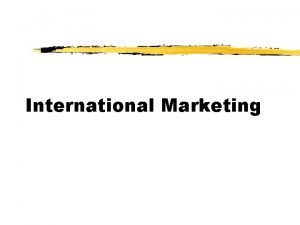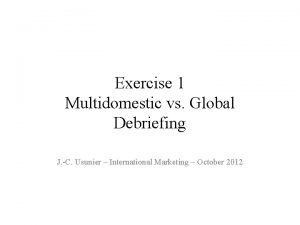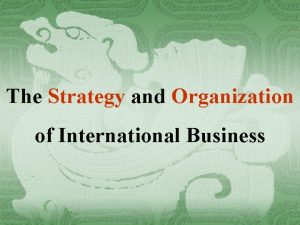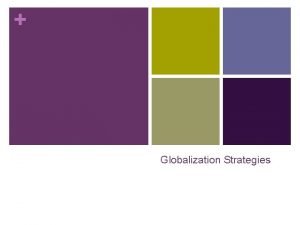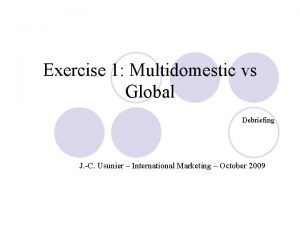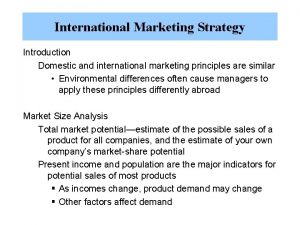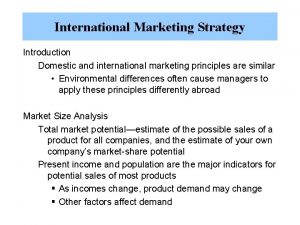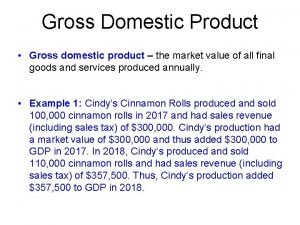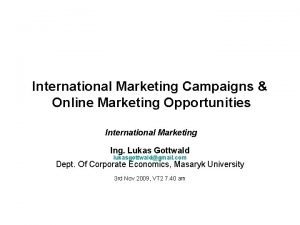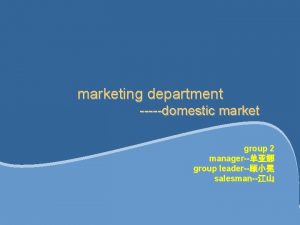International Marketing International Marketing Domestic Market Extension Multidomestic




















- Slides: 20

International Marketing

International Marketing òDomestic Market Extension òMulti-domestic òGlobal Marketing

Domestic Market Extension ò Sales of domestic products in int. markets. ò Domestic orientation ò International Market secondary ò Firm seeks markets similar to domestic. ò Little adaptation of product or marketing mix. ò Usually produced domestically

Multi-Domestic Orientation òSeparate operations in each country production, marketing etc. òDifferent strategies and marketing mixes òVery little interaction òMarkets could be very different.

Global-Marketing Orientation òViews the world as one market. òDevelop product and marketing strategies for world markets. òStandardize as far as possible, adapt where necessary. òEconomies of scale, transfer of knowledge and technology, global image, and better competitive position.

International vs. Domestic - Marketing Mix. ò Standardization/Differentiation mainly in terms of Product and Promotions. ò Product and Promotion Extension (Standardization) ò Product Extension/Promotion Adaptation ò Product Adaptation/Promotion Extension ò Dual Adaptation (Differentiated) ò Product Invention

Five International Product and Promotion Strategies Promotion Product Do not change promotion Do not change product Adapt product Straight extension Product adaptation Develop new product Product invention Adapt promotion Communication adaptation Dual adaptation

Three components which could be changed. z. Core component; packaging component; and support services component. z. Core component - Physical product, design features, functional features. z. Culture and use; standards or regulations; minor changes easier; major changes costly; functional features easy to adapt.

Three components which could be changed. z. Packaging component - Price, quality, styling, color, trademark, brand name, etc (psychological features). z. Economic or environmental requirements; Govt. regulations; Distribution requirements; consumer/cultural requirements.

Three components which could be changed. òSupport services component - deliveries, warranty, repair and maintenance, spare parts etc. òMarket characteristics, size, competition, level of development etc.

Country of origin effects. òStereotypes about products and countries. òEnglish Tea, French Perfume, Chinese Silk, Italian leather, Japanese cars and electronics. òUsually product specific. òStereotypes based on level of industrialization. òCan be overcome with good marketing.

Pricing. ò Objectives depend upon company orientation ò Standard worldwide Pricing – Based on average unit costs of fixed, variable and export related costs. ò Dual Pricing – Domestic and export prices are differentiated. Cost-plus pricing and marginal cost method. Cost-plus – full allocation of domestic and foreign costs. Marginal cost – Fixed costs for plants, R&D, Domestic overhead, and domestic marketing are disregarded. ò Market-differentiated pricing – demand–oriented. Marginal costs and export-related costs considered.

Variables that influence international pricing ò Taxes and tariffs - Specific duty, Ad Valorem, Combination. ò Inflation - Time, Payment terms, possible price control. ò Exchange rate Fluctuation - Prices of products and profits. ò Middlemen and transportation costs - Longer, diverse, underdeveloped, smaller order quantities, could all increase costs. ò Parallel Imports.

Parallel Imports/ Gray Markets. z Value of currencies. z Pricing policies. z Costs of transportation less than price differential. z Price controls or quotas. z Exclusive distribution agreements. z In the US – Gray market for Cars, Watches, cameras etc. – valued at $6 -10 billion.

Global Advertising and Promotion Effort. òGlobal or standardized advertising strategy. òPattern Advertising (similar basic message with some local variation) òCustomized. òMarketing strategy; Cultural differences; Behavior in terms of the product; Media availability.

Global advertising strategy. z. Developed on a global basis not exported. z. Most large firms do not use, only 8% of U. S. multi-national firms.

Pattern advertising. z. Plan globally act locally. z. Broad outlines or basic positioning given but details can be adapted. z. Assuming that there are some differences in culture and consumer behavior even if primary function is the same.

Creative challenges. ò Media Regulations – comparative advertising – e. g. , Germany prohibits use of superlatives. time allocations – e. g. , In Italy 12% ads per hour. , special taxes – e. g. , Japan, type of product, type of copy and illustration, etc. ò Language limitations - translating ad slogans, literacy levels, use of different languages.

Creative challenges. òCultural diversity - Symbols, colors, tastes, values and beliefs etc. - subcultures. òProduction and cost limitations - Poor quality printing, lack of high grade paper, film editing and processing facilities, high comparative cost for quality. òMedia - Availability, Audience data, international media.

Advertising agencies. ò Local agency. ò Company owned agency. ò Multinational Agency with local branches. Survey says 32. 5% usingle agency worldwide. 20% two agencies. 5% using three. 10% using four. 32. 5% using more than four.
 Domestic market extension concept
Domestic market extension concept Regular foreign marketing
Regular foreign marketing Domestic market extension concept
Domestic market extension concept Multidomestic orientation
Multidomestic orientation Transnational strategy
Transnational strategy Brand extension vs line extension
Brand extension vs line extension Market leader challenger follower nicher examples
Market leader challenger follower nicher examples International segmentation
International segmentation Spontaneous budget explorers
Spontaneous budget explorers Multidomestic corporation
Multidomestic corporation A multidomestic corporate-level strategy is one in which:
A multidomestic corporate-level strategy is one in which: Vertical product differentiation
Vertical product differentiation Cocacola
Cocacola Multidomestic orientation
Multidomestic orientation Multidomestic definition
Multidomestic definition Performance ambiguity lowers the cost of control.
Performance ambiguity lowers the cost of control. Global matrix structure
Global matrix structure Starbucks multidomestic strategy
Starbucks multidomestic strategy Multi domestic strategy
Multi domestic strategy Pros and cons of tall organizational structure
Pros and cons of tall organizational structure Starbucks multidomestic strategy
Starbucks multidomestic strategy
